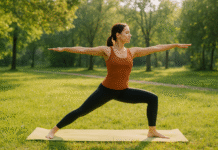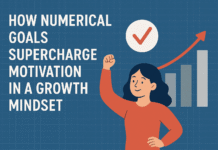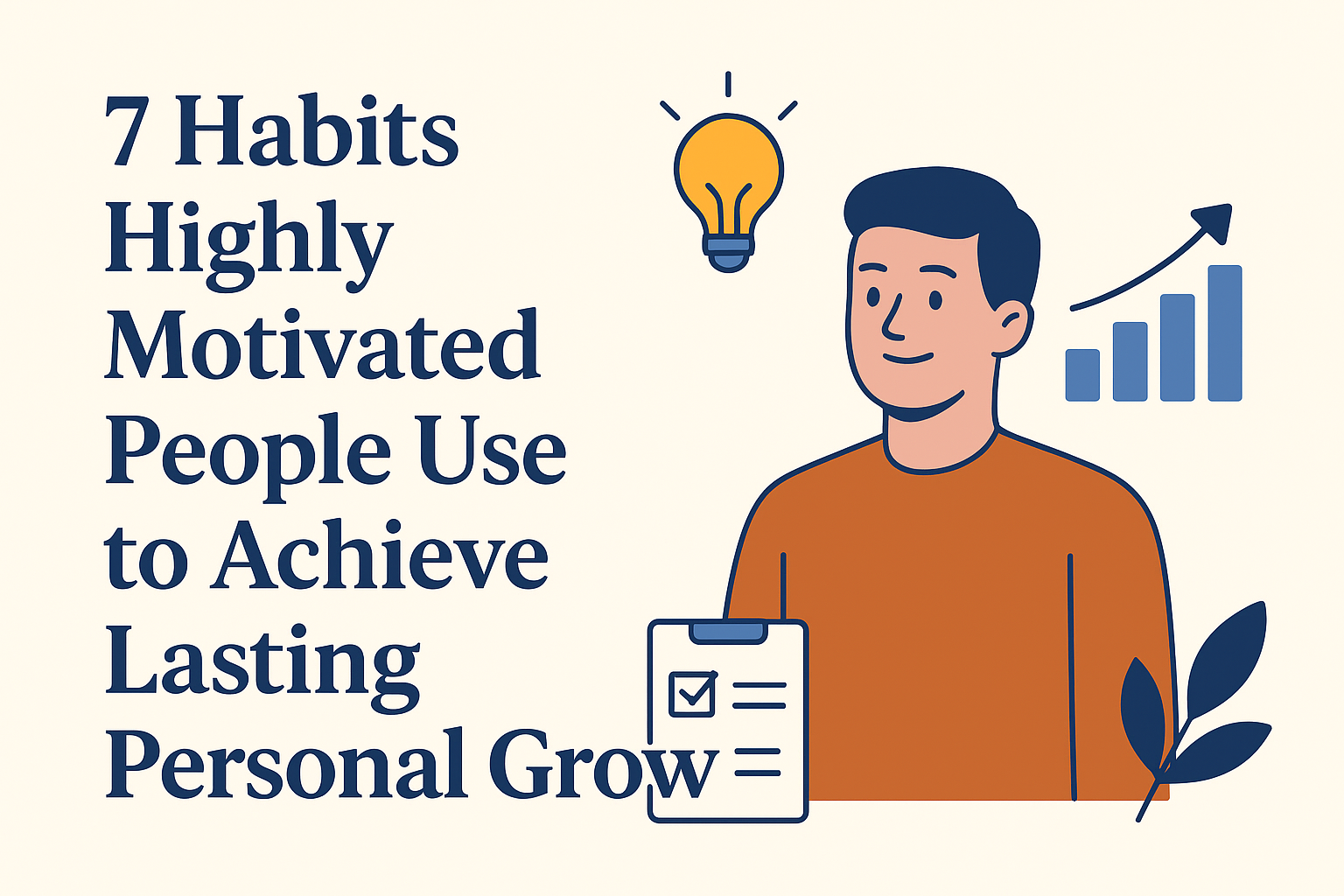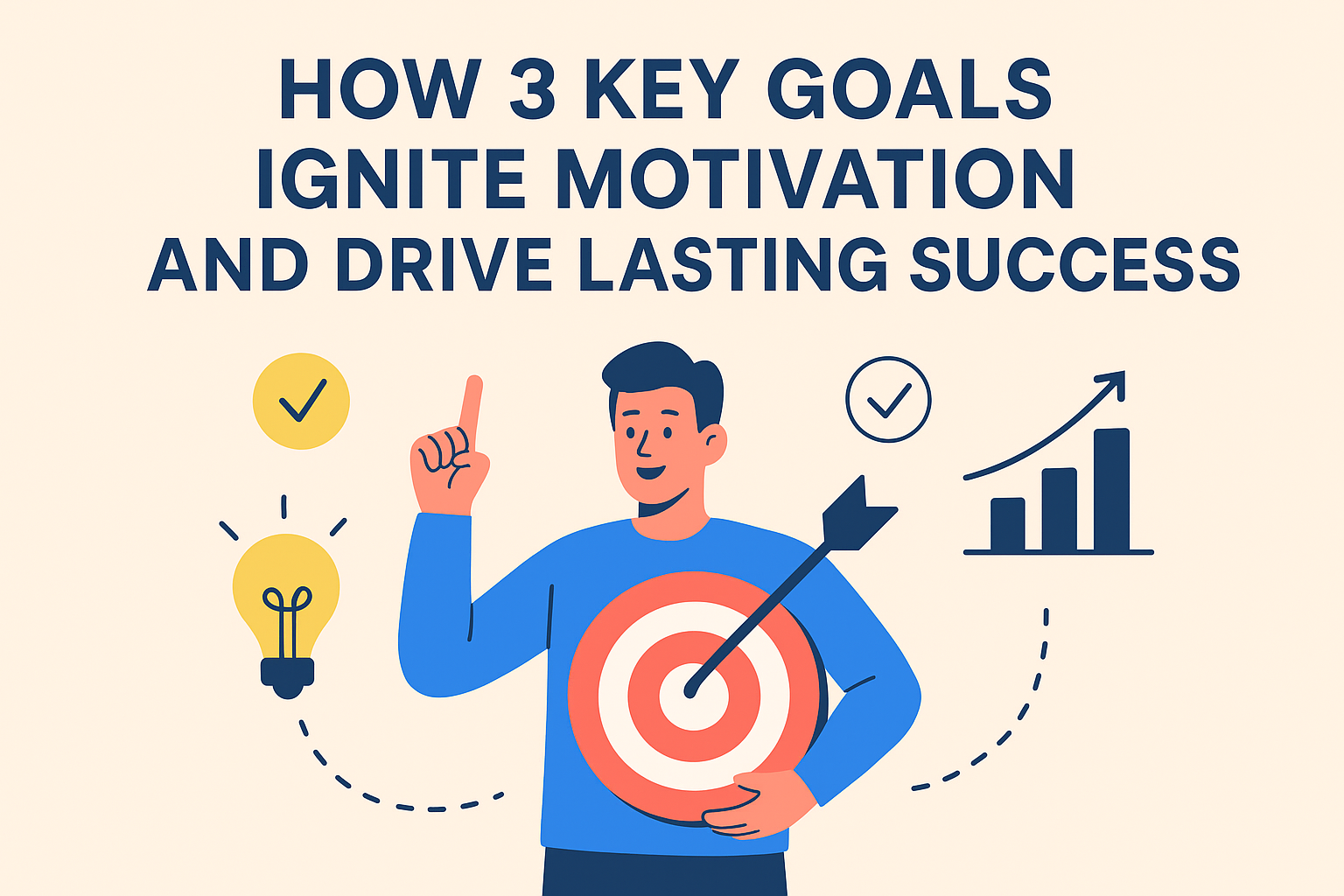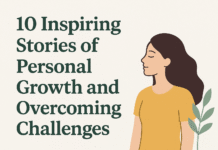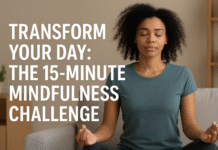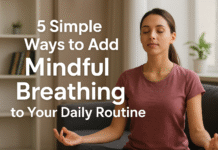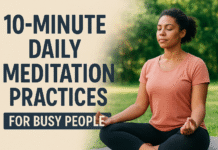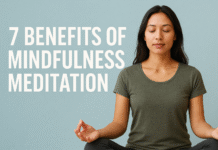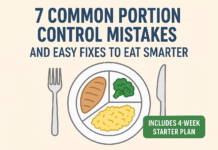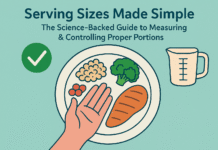If you’ve landed here because you want to start meditating but don’t know where to begin, you’re in the right place. This article walks you through the top five meditation techniques for beginners, explains what each practice does, gives step-by-step beginner instructions, and supplies practical plans, troubleshooting tips, progress metrics, and a full 4-week starter roadmap so you can start today and keep going. Important: this article is informational and not medical advice. If you have a medical or mental-health condition, please consult a qualified healthcare professional before starting a new meditation or breathwork routine.
Key takeaways
- Meditation can reduce stress, improve sleep, and support emotional regulation — simple daily sessions move the needle.
- Five beginner-friendly techniques are: Breath (mindful breathing), Body Scan, Guided Visualization, Loving-Kindness (Metta), and Mantra/Repeating-Phrase meditation. Use one technique at a time to build habit.
- Start small and be consistent: aim for 5–15 minutes daily the first month and track sessions and perceived stress or sleep quality.
- Progression matters: once 10–15 minutes daily feels comfortable, gradually increase session time or add focused practices (walking, longer sits, or an 8-week MBSR sequence).
- Practical tools help: a short checklist, a troubleshooting guide, and a 4-week starter plan in this article will make starting less fiddly.
Why five techniques — and who this article is for
Different meditation techniques train different skills: attention, body awareness, emotional openness, compassion, and focused repetition. For beginners it’s helpful to try a handful of accessible practices so you can pick the one that “sticks.” That’s exactly what this guide does: it names five reliable, easy-to-learn techniques, teaches each thoroughly, and shows how to progress safely. The evidence base for meditation supporting stress reduction, mood improvements, sleep, and some physical health markers is strong enough to recommend practice for most adults, while also noting important caveats for people with serious mental-health issues.
This article is written for:
- Busy adults who want simple, practical steps to start meditating.
- Newcomers who prefer evidence-based suggestions and clear progression paths.
- People who want habit designs (checklists, weekly plans) rather than abstract advice.
Quick note on evidence and safety
Meditation is widely studied; reviews show consistent benefits for stress, anxiety and sleep, and promising effects on mood and certain physical markers. However, results vary by practice type, dose, and individual differences. If you are taking medication for depression, anxiety, or have a history of trauma, discuss a meditation plan with a clinician first. Some people experience temporary increases in difficult emotions when beginning meditation — trained instructors can help navigate that. NCCIH
Breath (Mindful Breathing)
What it is and core benefits
Breath meditation — often called breath awareness or mindful breathing — means gently placing attention on the sensations of breathing: the in-breath, the out-breath, and the physical movement that accompanies them. It’s a foundational, entry-level practice that anchors attention and reduces physiological stress reactivity. Short, consistent breath sessions reliably reduce perceived stress and can improve attention and emotion regulation over weeks.
Requirements / low-cost alternatives
- Requirements: None. You only need a quiet-ish spot and a comfortable seat or chair.
- Low-cost alternatives: Use a chair, couch, or lie on a bed. You can also practice while standing in line or waiting for the kettle.
Step-by-step instructions (beginner)
- Set a timer for 5 minutes to start. Use your phone’s timer or a simple meditation app.
- Sit comfortably with a straight back (or lie down if needed). Hands can rest in your lap.
- Close your eyes softly or keep them open with a soft gaze.
- Notice your breath as it enters and leaves. Focus on where you feel it most clearly — nostrils, chest, or abdomen.
- Count (optional): on the in-breath think “one,” out-breath “two,” up to five and then restart. Counting helps focus.
- When your mind wanders, label “thinking” or gently bring attention back to the breath. No judgement.
- Finish slowly: let the timer ring and take a full, intentional breath before opening your eyes.
Beginner modifications and progressions
- Simplify: If 5 minutes feels long, start with 1–2 minutes using the same steps.
- Progress: Increase by 1–2 minutes every few days until you reach 10–20 minutes per session.
- Add structure: Try 4:6 breathing (inhale 4 counts, exhale 6) or the 4-7-8 sequence for relaxation after foundational breath awareness. Verywell Mind
Recommended frequency/duration/metrics
- Beginner target: 5–10 minutes daily for week 1; 10–20 minutes by week 3–4.
- Frequency: daily practice builds attention fastest.
- Metrics to track: session count per week, minutes per session, perceived stress (0–10), and sleep onset time.
Safety, caveats, and common mistakes
- Common mistake: forcing the breath or trying to “stop thoughts.” The breath is an anchor, not a performance.
- Caveat: deep breathwork (rapid or prolonged breath retention) can provoke dizziness or emotional arousal for some people; keep an easier pace if you feel lightheaded.
- If distress arises: stop, ground with simple sensory input (feet on floor, drink water), and consider guidance from a teacher or clinician. Harvard Health
Sample mini-plan (2–3 steps)
- Five minutes sitting breath awareness, count to five and repeat.
- After the session, jot one sentence about how you feel.
Body Scan Meditation
What it is and core benefits
Body scan meditation involves moving mindful attention through the body, typically from toes to head or vice versa, noticing sensations without judgment. It increases interoceptive awareness (sensing internal bodily states), helps release tension, improves sleep quality, and supports pain coping strategies. It’s a core practice used in many clinical programs for stress and chronic pain management. Medical News Today
Requirements / low-cost alternatives
- Requirements: A quiet place to lie down or recline, and about 10–30 minutes.
- Alternatives: If you can’t lie down, perform a seated body scan with the same attention sequence.
Step-by-step instructions (beginner)
- Set 10–15 minutes for your first few sessions.
- Lie down on a mat, bed, or recliner with arms relaxed.
- Take a few slow breaths to settle.
- Bring attention to the toes. Notice temperature, pressure, tingling, or absence of sensation.
- Move attention slowly up through feet, ankles, calves, knees, thighs, hips, lower back, abdomen, chest, hands, arms, shoulders, neck, face, and scalp.
- If you notice pain or tension, hold attention there for a few breaths without trying to change it.
- Finish by opening awareness to the whole body and breathing a few mindful breaths.
Beginner modifications and progressions
- Shorten: Do a 5-minute “quick body scan” focusing on feet, belly, and shoulders.
- Extend: As you grow comfortable, extend to 20–30 minutes and include subtle movement or gentle stretching.
- Add audio: Use a guided body-scan recording for the first 10 sessions to maintain structure. Verywell Mind
Recommended frequency/duration/metrics
- Beginner target: 10–15 minutes, 3–5 times per week.
- Progression: move to 20–30 minutes and daily practice if sleep or pain are targets.
- Metrics: minutes per session, nights with improved sleep, self-rated muscle tension (0–10).
Safety, caveats, and common mistakes
- Common mistake: expecting dramatic relaxation immediately — body awareness can sometimes initially increase awareness of discomfort.
- Caveat: for people with certain trauma histories, body focus can be triggering. Seek trauma-informed guidance if sensations provoke distress.
- Tip: if lying causes dizziness, practice seated and keep sessions shorter.
Sample mini-plan (2–3 steps)
- Ten-minute body scan from feet to hips.
- Two minutes of relaxed breathing and a short journal note on tension spots.
Guided Visualization (Guided Imagery)
What it is and core benefits
Guided visualization uses a narrator to lead your attention through calming images, scenes, or scenarios (a beach, a forest, a quiet room). It helps stabilize attention, reduce anxiety, and create mental rehearsal for relaxation or performance. It’s practical for people who find open awareness tough because the imagery provides a clear focal path.
Requirements / low-cost alternatives
- Requirements: A guided audio recording or a short script you read to yourself.
- Low-cost alternatives: Use free guided meditations available from reputable mindfulness teachers or apps; or write a short 2-minute script describing a calm scene and read it aloud.
Step-by-step instructions (beginner)
- Choose a guided track (5–15 minutes) or set a timer if self-guiding.
- Sit or lie comfortably.
- Close your eyes and take three grounding breaths.
- Follow the guide’s images — notice sensory details: sights, sounds, smells, textures.
- If your mind wanders, gently bring attention back to the narrator’s words or to a single sensory detail (e.g., the sound of waves).
- End the session by opening your eyes slowly and taking a moment to notice your body.
Beginner modifications and progressions
- Simplify: Use 3-5 minute guided tracks for the first week.
- Progress: Move from relaxing visualizations to goal-oriented imagery (e.g., practicing a calm reaction before a meeting).
- Create your own script: After 2–4 weeks, practice improvising your own 5-minute guided visualization to strengthen internal imagery skills.
Recommended frequency/duration/metrics
- Beginner target: 5–10 minutes daily or every other day.
- Metrics: number of guided sessions per week, anxiety ratings before and after (0–10), sleep latency.
Safety, caveats, and common mistakes
- Common mistake: choosing guided content that’s overly busy or commercial — calmer voices and simpler scenes work better.
- Caveat: vivid imagery can sometimes trigger strong emotions or memories; pause if that happens and return to breath or body scan.
- Tip: prefer guides recorded by calm, steady narrators; avoid music or soundscapes that spike arousal.
Sample mini-plan (2–3 steps)
- Five-minute beach visualization guided track.
- One minute of slow breath awareness to close.
Loving-Kindness (Metta) Meditation
What it is and core benefits
Loving-kindness (Metta) meditation intentionally cultivates goodwill, compassion, and warm intentions first toward oneself, then toward others. Regular Metta practice increases positive affect, social connectedness, and empathy, and can reduce social anxiety or self-criticism. It’s a practice both uplifting and practical for relationship and mood benefits.
Requirements / low-cost alternatives
- Requirements: No props; an optional quiet space and a short script.
- Alternatives: Send the well-wishing phrases quietly to people you know, or use a mobile reminder to repeat a Metta phrase during the day.
Step-by-step instructions (beginner)
- Set 5–15 minutes.
- Sit comfortably and take three grounding breaths.
- Begin with yourself: silently repeat phrases like, “May I be safe. May I be healthy. May I live with ease.”
- Expand outward to a loved one, a neutral person, a difficult person, and then to all beings; repeat the same (or slightly adapted) phrases.
- If emotions arise (warmth, resistance, sadness), hold them with gentle curiosity rather than forcing positive feeling.
- Finish with a breath or short body scan.
Beginner modifications and progressions
- Short version: Practice two phrases (e.g., “May I be well,” “May I be peaceful”) for 3–5 minutes.
- Longer practice: Work through five categories (self, loved one, neutral, difficult, whole world) in a 20-minute session.
- Alternate: Pair Metta with breath awareness for increased stability.
Recommended frequency/duration/metrics
- Beginner target: 5–10 minutes, 4–6 times per week.
- Metrics: self-compassion scale (brief rating), frequency of negative self-talk, warmth ratings toward others.
Safety, caveats, and common mistakes
- Common mistake: forcing feelings of affection. Metta is a practice of intention, not performance.
- Caveat: for people with strong unresolved interpersonal trauma, invoking certain people can be triggering. Work with a clinician if that occurs.
- Tip: be gentle; if repeating phrases feels hollow, focus on intention rather than emotional intensity.
Sample mini-plan (2–3 steps)
- Five minutes of Metta for self and a loved one.
- One deep breath and a short reflection on any shifts noticed.
Mantra / Repeating-Phrase Meditation
What it is and core benefits
Mantra meditation involves mentally repeating a word, phrase, or short sound (a mantra) to steady attention. It can be secular or come from traditional systems. Mantra practice helps stabilize attention, reduce discursive thinking, and create a simple, repeatable focus that’s easy to use anywhere. For some people, mantra practices lower stress and improve concentration faster than open awareness approaches.
Requirements / low-cost alternatives
- Requirements: A chosen phrase or short sound; quiet space recommended for initial sessions.
- Alternatives: Use a secular phrase such as “calm” or “peace,” or a short sequence like “I am here” repeated silently.
Step-by-step instructions (beginner)
- Choose a mantra: one word or short phrase that feels neutral or positive.
- Set 5–15 minutes.
- Sit comfortably and begin silently repeating the mantra with each breath or at a steady rhythm.
- If the mind wanders, return to the mantra — don’t analyze the distraction.
- Close by letting the mantra fade and noticing the space it leaves.
Beginner modifications and progressions
- Simplify: Start with 3–5 minutes repeating a single word.
- Progress: Add longer blocks of 15–20 minutes and combine with walking meditation using the mantra rhythm.
- Alternative: Use an external chant or recording to follow if silent repetition is difficult.
Recommended frequency/duration/metrics
- Beginner target: 5–15 minutes daily.
- Metrics: session frequency, minutes, perceived focus improvement (self-rating), or number of distractions per session.
Safety, caveats, and common mistakes
- Common mistake: choosing emotionally charged mantras that stir feelings — prefer neutral or calming ones until you’re experienced.
- Caveat: if the mantra becomes associated with strong emotions, switch to a neutral phrase or breath focus.
- Tip: silent repetition is generally safe; loud chanting is more activating and not recommended before sleep.
Sample mini-plan (2–3 steps)
- Five minutes of silent “peace” repetition with breath.
- One minute of breath awareness to ground.
Practical add-ons: warm-ups, quick-start checklist, and troubleshooting
Quick-start checklist (five items)
- Choose one technique from the five above and commit to it for one week.
- Set a daily timer (5–10 minutes to start).
- Pick the same time each day (morning or before bed works well).
- Record sessions in a simple habit tracker (date, minutes, notes).
- Reflect weekly: note changes in sleep, mood, or stress levels.
A short warm-up / mini ritual (1–2 minutes)
- Stand and take three full, slow breaths (in through the nose, out through the mouth).
- Roll shoulders and soften jaw.
- Sit and begin the chosen practice.
Troubleshooting / common pitfalls
- “I can’t stop thinking.” That’s not a problem — noticing thought is the practice. Label and return to your anchor.
- “I fall asleep.” Try sitting upright, open gaze, or practice earlier in the day. Shorten the session if fatigue is acute.
- “It’s boring.” Try a different technique (guided visualization or Metta) or shorten sessions to keep interest.
- “I get anxious or upset.” Pause the session and ground with breath; if this persists, seek trauma-informed guidance.
How to measure progress and results
Simple, practical metrics
- Consistency: sessions per week (target: 5–7).
- Time: average minutes per session (target: increase from 5 to 15 over 4 weeks).
- Subjective stress rating: daily quick 0–10 before and after sessions.
- Sleep measures: time to fall asleep and total sleep time (self-report).
- Mood snapshot: weekly “how am I overall?” 0–10.
Objective (if you want to be precise)
- Use a sleep tracker or a smartphone app for sleep latency.
- For attention tracking, simple time-on-task or focus timers (Pomodoro) measured across weeks can show gains.
How long until you notice changes?
Most people notice small improvements in calm and focus within 1–3 weeks of consistent short practice. More robust changes in sleep, anxiety, or attention often appear after 6–8 weeks of regular practice. The classic 8-week MBSR structure is a useful benchmark for medium-term changes.
4-Week Beginner Roadmap (starter plan)
Goal: Build a durable daily habit and learn one technique deeply.
Structure below assumes a single technique focus (choose Breath, Body Scan, Guided Imagery, Metta, or Mantra).
Week 1 — Foundation (Days 1–7)
- Daily target: 5 minutes each day.
- Practice: Breath awareness or guided 5-minute track.
- Goal: Build consistency; log each session.
- Metric: 7 sessions by end of week; note immediate mood change (pre/post).
Week 2 — Solidify (Days 8–14)
- Daily target: 8–10 minutes each day.
- Practice: Continue chosen technique; add a daily 1-minute body awareness check.
- Goal: Increase comfort with sitting and noticing distractions.
- Metric: Average session >8 minutes; perceived stress rating improvement.
Week 3 — Expand (Days 15–21)
- Daily target: 10–15 minutes.
- Practice: Try a longer single session (15 minutes) mid-week. Introduce a short walking meditation (5 minutes).
- Goal: Learn to carry mindfulness into movement.
- Metric: One 15-minute session completed and logged.
Week 4 — Integrate (Days 22–28)
- Daily target: 12–20 minutes (mix short and long sessions).
- Practice: Alternate two different practices if desired (e.g., Breath + Metta). Do a reflective journal entry at week’s end.
- Goal: Decide which practice you want as “primary” going forward.
- Metric: Self-report of improved focus or sleep, consistent practice on at least 20 of 28 days.
Troubleshooting common beginner scenarios (detailed)
Problem: Irregular schedule — “I miss days.”
- Fix: Anchor practice to a strong daily cue (after morning coffee, before brushing teeth). Keep a visible timer or habit sticker.
Problem: Physical discomfort when sitting
- Fix: Use a chair, increase cushion support, or do a seated body scan. Shorten sessions and stand/walk practice if needed.
Problem: Dull or unhelpful guided tracks
- Fix: Try different teachers and shorter tracks. Voice, pacing, and script content matter; pick what calms you.
Problem: “Meditation made me worse”
- Fix: Stop, ground with breath, and consult a trauma-informed teacher or clinician. Some practices require professional support for vulnerable individuals.
How meditation fits with other routines (practical pairings)
- Before bed: body scan or guided visualization to aid sleep.
- Morning: short breath practice to set attention for the day.
- Between meetings: 2–3 minutes of mantra or breath to reset.
- Exercise days: short Metta practice to support body appreciation.
FAQs (10 questions)
1. How long do I need to meditate to see benefits?
Small benefits (less reactivity, slight calm) can appear in 1–3 weeks of daily short practice. More consistent changes in sleep, anxiety, and attention often require 6–8 weeks of regular practice.
2. What’s the best time of day to meditate?
The best time is the time you’ll consistently do it. Morning helps set attention for the day; evening practices can support sleep. Pick one and stick to it.
3. Is 5 minutes enough?
Yes. Five minutes daily is a meaningful start and beats irregular long sits. Gradually increase time as habit strengthens.
4. Do I need special equipment?
No. Comfortable clothing, a quiet spot, and a timer are sufficient. An optional cushion or chair makes sitting more comfortable.
5. Which technique is best for anxiety?
Breath awareness and guided visualization are often effective first choices. Body scan and loving-kindness can also help. If anxiety is severe, consult a clinician for a tailored plan. Healthline
6. Can meditation replace therapy or medication?
Not necessarily. Meditation is a helpful tool and adjunctive therapy. For diagnosed mental-health conditions, follow professional treatment plans and consult clinicians before replacing medication.
7. What if I can’t stop my mind from racing?
That’s normal. The skill is noticing the mind has wandered and kindly bringing attention back. Use labels (“thinking”) to defuse engagement.
8. Is guided meditation better for beginners than silent meditation?
Guided meditations can be easier at first because the voice provides structure and reduces uncertainty. Silent practice often follows as confidence grows.
9. How do I track progress?
Track session counts, minutes, brief pre/post session mood/stress ratings, and sleep metrics. Consistency is the strongest predictor of progress.
10. Can meditation change the brain?
Research shows meditation practices are associated with changes in attention and emotional regulation circuits in the brain. These effects develop with repeated practice over weeks to months.
Final tips, motivation, and practice reminders
- Be gentle with yourself. Meditation is training, not performance.
- Consistency beats intensity. Short daily practice is better than rare long sessions.
- Mix but choose. It’s okay to sample techniques, but pick one as your primary practice for four weeks.
- Use cues and rewards. Pair practice with an enjoyable cue (tea, a favorite cushion) to strengthen habit.
- Ask for help. If meditation triggers difficult emotions or memories, seek support from a trauma-informed teacher or mental-health professional.
Conclusion
Meditation is a skill you build by returning your attention, again and again. The five techniques outlined here give you multiple, practical entry points — breath, body scan, guided visualization, loving-kindness, and mantra practice. Start small, stay consistent, track simple metrics, and lean into the routine. In a few weeks you’ll likely notice more calm, clearer focus, and better sleep. Keep practicing — progress is gentle but real.
Ready to start? Try this right now: sit tall for three minutes, breathe slowly, and pick one word to repeat — “calm” — and repeat it gently with each breath.
Call to action: Start your first 5-minute practice today and log it — small steps compound.
References
- Meditation and Its Mental and Physical Health Benefits in 2023, PubMed Central (PMC), 2023. https://www.ncbi.nlm.nih.gov/pmc/articles/PMC10355843/ PMC
- Meditation and Mindfulness: Effectiveness and Safety, National Center for Complementary and Integrative Health (NCCIH), updated 2022. NCCIH
- Breath meditation: A great way to relieve stress, Harvard Health Publishing, April 15, 2014. Harvard Health
- Body Scan Meditation: Benefits and How to Do It, Healthline, updated 2020–2024 (page update). Healthline
- How to Do a Body Scan Meditation, Cleveland Clinic Health Essentials, March 2023. Cleveland Clinic
- Mindful breath awareness meditation facilitates efficiency gains in attention networks, Scientific Reports (Nature), 2018. Nature
- Effect of breathwork on stress and mental health: A meta-analysis, Scientific Reports (Nature), 2022. Nature
- Mindfulness-Based Stress Reduction (MBSR), UMass Memorial Center for Mindfulness / UMass Health, program page. UMass Memorial Health
- Mindfulness-Based Stress Reduction (MBSR), University of Minnesota, program overview. Bakken Center for Spirituality & Healing
- 12 Science-Based Benefits of Meditation, Healthline, updated August 15, 2024. Healthline


